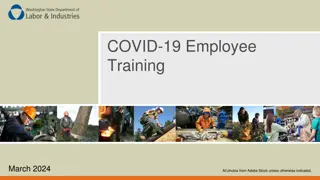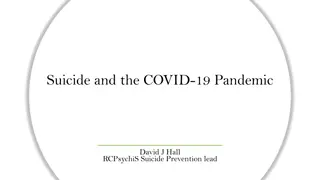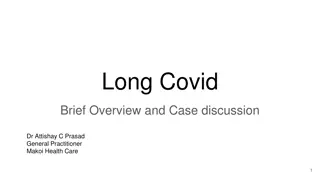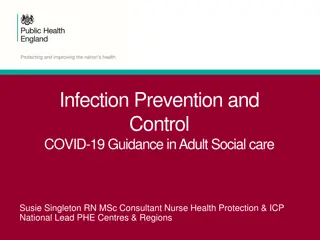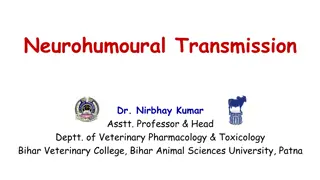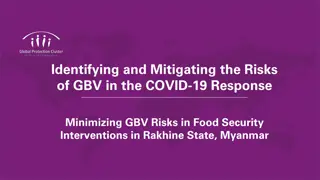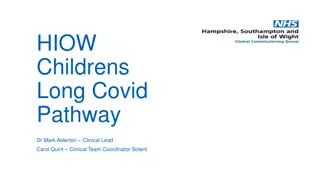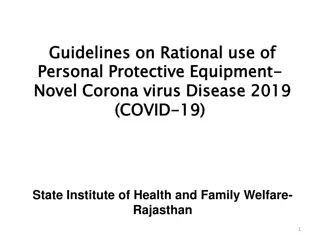Understanding COVID-19: Prevention, Transmission, and Risks
Increase health and safety awareness regarding COVID-19, focusing on recognizing symptoms, understanding transmission methods, and identifying risk factors. Learn about the SARS-CoV-2 virus, its incubation period, and ways to prevent workplace exposure. This educational material aims to enhance knowledge and promote safety measures in response to the pandemic.
Download Presentation

Please find below an Image/Link to download the presentation.
The content on the website is provided AS IS for your information and personal use only. It may not be sold, licensed, or shared on other websites without obtaining consent from the author. Download presentation by click this link. If you encounter any issues during the download, it is possible that the publisher has removed the file from their server.
E N D
Presentation Transcript
Infectious Disease Prevention: SARS-CoV-2 Virus That Causes COVID-19 16 VAC 25-220
GOAL AND LEARNING OBJECTIVES Goal: Increase health and safety awareness employees with potential exposure to COVID-19 as required by 16VAC25-220 Learning objectives: After attending participants will be able to: Recognize the signs and symptoms, risk factors, and transmission of COVID-19 disease. Understand the risk of workplace exposure to COVID-19. Be familiar with the infection control methods used by your employer to prevent and respond to COVID-19 exposure in our workplace. Implement the steps your employer has taken to protect you and your coworkers.
WHY HAVE A STANDARD AND WHO DOES IT APPLY TO? Prevent the spread of the virus Applies to every place of employment with in the jurisdiction of the VOSH program Based on exposure risk levels based on hazards present or job tasks and defined as Very High, High, Medium, and Lower.
WHAT IS SARS-COV-2? SARS-CoV-2 is the virus that causes coronavirus disease 2019 (COVID-19) SARS = severe acute respiratory distress syndrome Spreads easily person-to-person particularly when someone sneezes Little if any immunity in humans Detailed information: https://www.cdc.gov/coronavirus/2019-ncov/index.html
TRANSMISSION Droplet - respiratory secretions from coughing or sneezing landing on mucosal surfaces (nose, mouth, and eyes). COVID-19 is spread from person to person mainly through coughing, sneezing, and possibly talking, and breathing. Aerosol - a solid particle or liquid droplet suspended in air. Contact -Touching something with SARS CoV-2 virus on it and then touching mouth, nose or eyes. Other possible routes: Through fecal matter.
INCREASED RISK FACTORS Those with elevated risk of exposure include: Close contacts of persons with COVID-19. Healthcare workers caring for patients with COVID-19. Workers providing critical services and operations. 6
INCUBATION PERIOD The incubation period is the time between exposure to a virus and the onset of symptoms. With COVID-19, symptoms may show 2-14 days after exposure. CDC indicates that people are most contagious when they are the most symptomatic. Several studies show people may be most contagious before developing symptoms.
COVID-19 CAN CAUSE MILD TO SEVERE SYMPTOMS Most common symptoms include: Fever Cough Shortness of breath Other symptoms may include: Sore throat Runny or stuffy nose Body aches Headache Chills Fatigue Gastrointestinal: diarrhea, nausea Loss of smell and taste
INCREASED RISK OF SEVERE ILLNESS COVID-19 poses a greater risk for severe illness for people with underlying health conditions: Heart disease Lung disease such as asthma Diabetes Suppressed immune systems The elderly have higher rates of severe illness from COVID-19. Children and younger adults have had less severe illness and death. Because COVID-19 is new, there are a lot of scientific unknowns such as the impact on pregnant women and their fetuses.
SEVERE SYMPTOMS EMERGENCY WARNING SIGNS FOR COVID-19 Most people will have mild symptoms and should recover at home and NOT go to the hospital or emergency room. Get medical attention immediately if you have: Difficulty breathing or shortness of breath. Persistent pain or pressure in the chest. New confusion or inability to arouse. Bluish lips or face.
Social Distancing Self monitoring Post signs Offer disposable face masks PPE Clean and Disinfect Training Prohibit infected workers PROTECT YOUR EMPLOYEES
LOWER RISK EXPOSURE RISK Do not require contact inside six feet LEVELS Minimal occupational contact Or can achieve minimal occupational contact
MEDIUM RISK: Require more than minimal occupational contact inside six feet EXPOSURE RISK waiters, grocery store workers, agricultural workers, construction workers, domestic service workers, hairdressers, fitness instructors, workers in poultry and meat processing facilities, manufacturing workers, and healthcare workers in settings without known or suspected sources of COVID-19 LEVELS
HIGH RISK: high potential for employee exposure inside six feet EXPOSURE RISK hospital workers, first responders, medical transport providers, correctional facilities, mortuary services workers, medical and dental staff, non-medical support staff, long term care facility staff, home healthcare workers, etc. LEVELS
VERY HIGH RISK: high potential for employee exposure inside six feet EXPOSURE RISK LEVELS performing specific medical (e.g., aerosol generating procedures), postmortem, or laboratory procedures with specimens from an individual
DETERMINING EXPOSURE RISK LEVEL Tasks Work environment Presence of the virus # employees/size of area Working distances Duration and frequency of exposure Hazards encountered
REQUIREMENTS Very high, high or medium Training Requirements of the standard Characteristics and methods of the spread Risk factors Awareness of transmission Safe & Health Work Practices PPE Anti-discrimination Infections Disease Preparedness and Response Plan
REQUIREMENTS Sick leave, telework, staggered shifts Provide policy Self reporting and monitoring Reporting positive test results Notification of positive test to all exposed employees Return to work procedures
PPE ASSESSMENT Assess Hazards Select PPE Uses/ Cleaning/Storage/Fit No Hazards Hazards Present PPE Needed Assessment Job Task Hazards Likely to be Present PPE Needed
PPE ASSESSMENT STEP 1: Inform affected employees of the process Step 2: Review data Step 3: Conduct a walk through survey Step 4: Determine the hazard risk level Step 5: Determine Controls to protect against COVID-19 Step 6: Make Document Accessible Step 7: Reassess the workplace as necessary by identifying and evaluating
PHYSICAL DISTANCING REQUIREMENTS Announcements, signage, or visual cues Decrease worksite density Controlled Access
COMMON AREAS - PHYSICAL DISTANCING Entrance Posting Occupancy of the space; physical distancing; washing/hand sanitizing; Cleaning and disinfecting of shared surfaces.
CLEANING Clean and disinfect high touch areas https://www.epa.gov/pesticide-registration/list-n-disinfectants-use- against-sars-cov-2-covid-19
WHAT TO DO IF YOU ARE SICK Stay home.Most people with COVID-19 have mild illness and can recover at home without medical care. Do not leave your home, except to get medical care. Do not visit public areas. Take care of yourself.Get rest and stay hydrated. Take over-the-counter medicines, such as acetaminophen, to help you feel better. Stay in touch with your doctor.Call before you get medical care. Be sure to get care if you have trouble breathing, or have any otheremergency warning signs, or if you think it is anemergency. Avoid public transportation, ride-sharing, or taxis.
WHEN TO QUARANTINE Stay home and monitor your health What counts as close contact? You were within 6 feet of someone who has COVID-19 for a total of 15 minutes or more You provided care at home to someone who is sick with COVID-19 You had direct physical contact with the person (hugged or kissed them) You shared eating or drinking utensils They sneezed, coughed, or somehow got respiratory droplets on you Stay home for 7-14 days after your last contact with a person who has COVID-19, following return to work policies required in the standard. Watch for fever (100.4 F), cough, shortness of breath, or other symptoms of COVID-19 If possible, stay away from others, especially people who are at higher risk for getting very sick from COVID- 19
Steps to take Stay home except to get medical care Monitor your symptoms. If you have an emergency warning sign (including trouble breathing), seek emergency medical care immediately Stay in a separate room from other household members, if possible Use a separate bathroom, if possible Avoid contact with other members of the household and pets Don t share personal household items, like cups, towels, and utensils Wear a mask when around other people, if you are able to WHO NEEDS TO ISOLATE? People who have COVID-19 People who have symptoms of COVID-19 and are able to recover at home People who have no symptoms (are asymptomatic) but have tested positive for infection with SARS- CoV-2
WHEN YOU CAN BE AROUND OTHERS AFTER YOU HAD OR LIKELY HAD COVID-19 I think or know I had COVID-19, and I had symptoms You can be with others after At least 10 days since symptoms first appeared and At least 24 hours with no fever without fever-reducing medication and Other symptoms of COVID-19 are improving **Loss of taste and smell may persist for weeks or months after recovery and need not delay the end of isolation
RETURN TO WORK Symptomatic employees known or suspected to be infected with the SARS-CoV-2 virus employees the symptom-based strategy excludes an employee are excluded from returning to work until all three of the following have been met: at least three days since the employee is fever-free (less than 100.0 F) for at least 24 hours have passed since recovery, defined as resolution of fever without the use of fever-reducing medications improvement in Respiratory symptoms, such as (e.g., cough, and shortness of breath) have improved, and at least 10 days have passed since symptoms first appeared.
Very high, and high INFECTIOUS DISEASE PREPAREDNESS & RESPONSE PLAN Medium with 11 or more employees Person responsible for implementing Webpage Guidance Document
INFECTIOUS DISEASE PREPAREDNESS & RESPONSE PLAN The plan shall contain: The name(s) or titles(s) of the person(s) responsible for administering the Plan Provide for employee involvement Exposure Risk Level
INFECTIOUS DISEASE PREPAREDNESS & RESPONSE PLAN The plan shall contain: Where, how, and what sources Engineering Controls Administrative Controls Work practices PPE
INFECTIOUS DISEASE PREPAREDNESS & RESPONSE PLAN The plan shall contain: Contingency plans for outbreaks Employee absenteeism; Control Measures Reduced workforce Suplly Chains Interrupted
INFECTIOUS DISEASE PREPAREDNESS & RESPONSE PLAN The plan shall contain: Infection prevention Hand washing Housekeeping Visitor education
INFECTIOUS DISEASE PREPAREDNESS & RESPONSE PLAN The plan shall contain: Identification and isolation Reporting when they are experiencing symptoms of COVID-19. Subcontractors
INFECTIOUS DISEASE PREPAREDNESS & RESPONSE PLAN The plan shall contain: CDC guidelines or Commonwealth of Virginia guidance documents Virginia Executive Orders
QUESTIONS? VOSH Consultation https://www.doli.virginia.gov/vosh-programs/consultation/ Outreach Documents https://www.doli.virginia.gov/covid-19-outreach-education-and- training/ Reporting https://redcap.vdh.virginia.gov/redcap/surveys/?s=LRHNP89XPK Questions covid19questions@doli.virginia.gov


